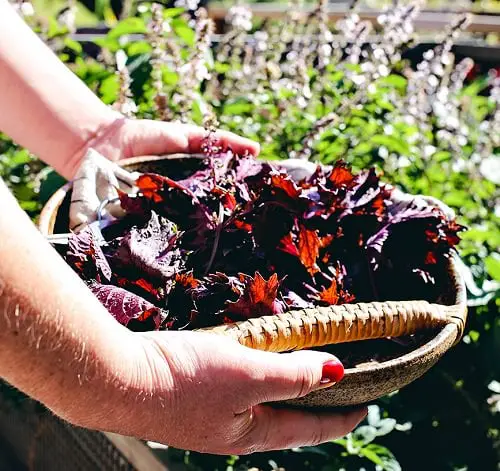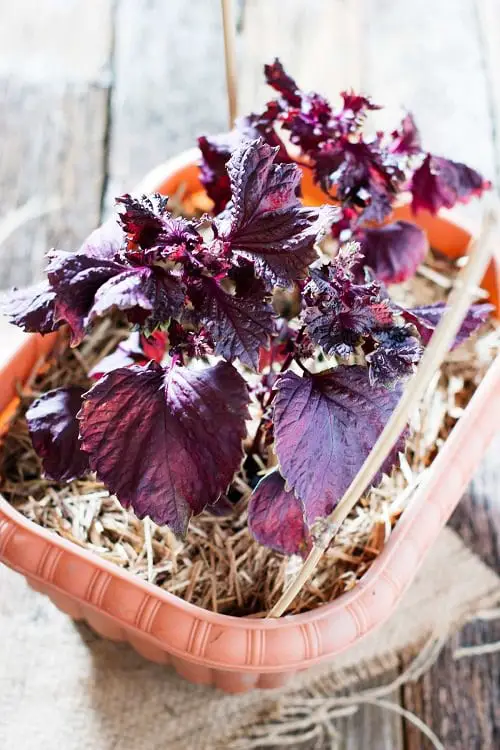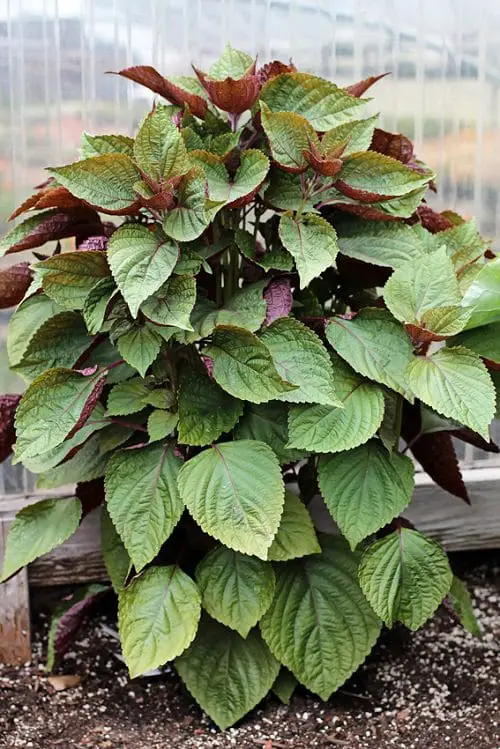Also known as the wild basil, Growing Shiso in containers is a wonderful idea to have a fresh supply of this oriental herb.

Shiso is a member of the mint family and largely used in Japanese cuisines. You must have had a taste of it in a mojito. Once you experience the refreshing taste of shiso, that’s a mix of mint, cumin, and nutmeg, you will want to have it more! As this herb is ideal for container planting, Growing Shiso is easy to have an endless supply of it.
Botanical Name: Perilla frutescens
Common Names: Purple shiso, Chinese basil, Wild basil, and Purple perilla, Beefsteak plant
Size: 18-35 inches
Check out our article on growing Wasabi in pots here.
What is Shiso Herb?
Also known as purple mint and Chinese basil, shiso belongs to the Lamiaceae or mint family. It features broad, oval-shaped red-green leaves with a metallic shine. The plant is grown widely in Japan, Thailand, China, Korea, India, and other Asian countries.
Shiso comes in two types. Perilla frutescens, the standard red and green form of the plant, has a bitter taste and used in pickles and cooked food. The green variety is used in salads, noodles, and to wrap sushi. The second type is P. frutescens var. crispa, which has curly purple shade leaves. It is often used as bedding. form often used in bedding and also considered a weed in some countries because it is toxic to livestock.
Best Shiso Varieties

- Akajiso: It features red leaves and used in making refreshing drinks.
- Atropurpurea: Comes in dark purple leaves and has uses in traditional medicines.
- Crispa: It forms ruffled and wrinkled bright green leaves. It is popular in a variety of Japanese cuisines like hiyayakko, and namerō.
- Aojiso: Has green leaves and used as a herb in cold noodle dishes like hiyamugi and sōmen.
Choosing a Container
Get a container that is at least 6-8 inches deep and wide, with a drainage hole at the bottom. Do not grow multiple plants in such a small container.
Planting Time
Start planting indoors during early spring, or outdoors in late spring when the night temperature is above 45 F (8 C). The plant is a tender annual and will not grow outdoors in winters. For warm climates, you can grow them anytime!
Growing Shiso
If you have an existing shiso plant, save seeds after the flower dries in fall. You can also purchase the seeds or a well-grown plant from any nursery or garden center.
From Seeds:
- The seeds are tough so they might take a long time to germinate. Soaking them in water for 24 hours will expedite the process.
- Sow seeds 1/4 inch deep into the seed mix.
- Mist the soil regularly instead of watering.
- The seeds will germinate in 7-14 days.
You can also propagate Shiso from cuttings but it is best to grow it from seeds.
Requirements for Growing Shiso

Location
The plant will do well in both full sun and partial shade. If you are living in a region with hot summer, grow it in dappled sunlight.
Soil
Use a rich, well-drained, slightly acidic to neutral soil with a pH 5.5-6.5. The soil must not be acidic. Soil that is too rich in organic content may promote foliage growth but will affect the flavor and aroma of the leaves.
Water
Never allow the plant to go dry completely. Also, avoid overwatering the plant. To find the right balance, check the moisture level by touching the topsoil. If it feels dry, water the plant until it comes out of the drainage hole.
Shiso Care
Fertilizer
Being a herb, it is not a heavy feeder and it should not be fertilized too often when grown whether in containers or outdoors. Feeding the plant occasionally, once every 3-4 months, using water-soluble all-purpose fertilizer should be enough. You can also mulch the top layer of the pot with compost.
Pests and Diseases
Thankfully, shiso plants are free from any pests and diseases.
Harvesting and Storage
You can start harvesting the plant once it grows up to 8 inches tall. Harvest as per the need for fresh use in cuisines. Cut off the leaves and flowers with a clean scissor or pruner.
You can store the leaves by keeping them in a zip pouch and store for 2-3 days in a refrigerator.
Culinary Uses of Shiso
Shiso leaves are widely used in soups, rice, or tempura. They are also wrapped around sushi. You can enjoy shredded shiso on fish tacos. Use the leaves in place of parsley by mixing it in soy sauce and sesame seeds. This will make for a delicious marinade for meat or grilled chicken. You can also try this recipe.
Health Benefits of Shiso
In Asian countries, its leaves are popular to make tea. It is rich in antioxidants and has anti-inflammatory and allergy-fighting properties. The plant is also used as a herbal remedy to treat asthma, arthritis, and eczema in Japan. The leaves are also rich in calcium, vitamin A, omega-3 fatty acids, and iron, which makes them a great addition in salads, soups, and stews.




I find your articles very interesting!!
Thank you.
Pretty sure Perilla plants are prone to Aphids.